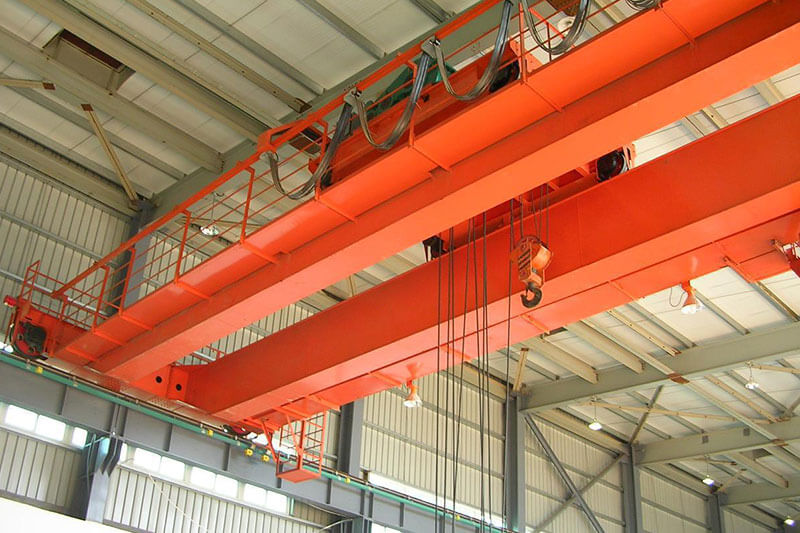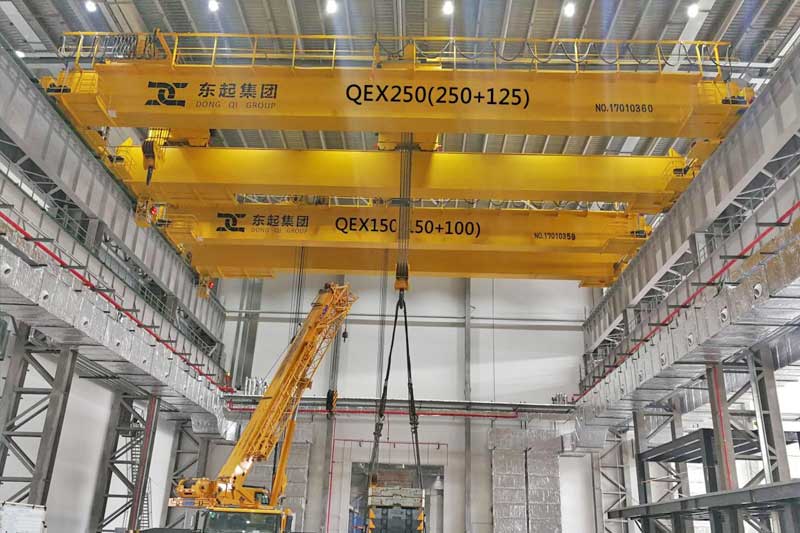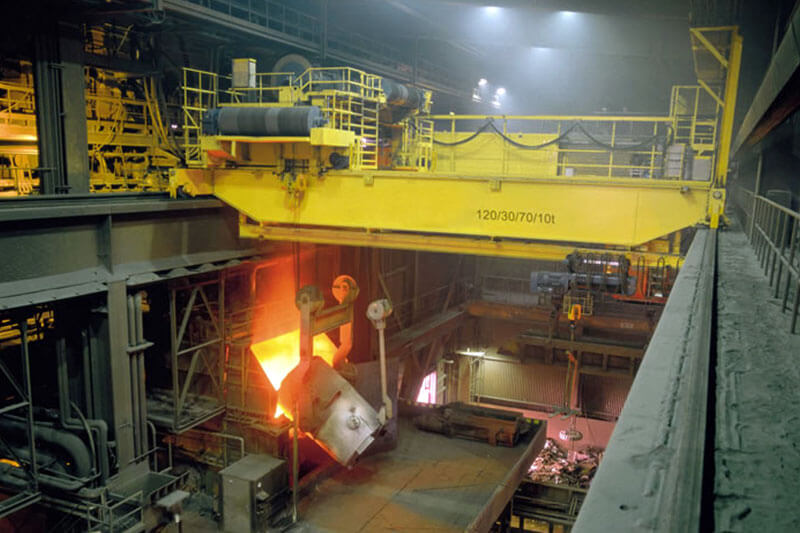Heavy Duty Overhead Cranes for Sale , 20 + to 500 ton Indusstrial Crane
Heavy duty overhead cranes for sale 20 to 500 tons for efficient industrial lifting solutions, get your industrial overhead crane for heavy duty material handling.
Heavy-duty overhead cranes are essential in various industrial sectors, designed to lift substantial weights ranging from 20 tons to 500 tons. These cranes play a crucial role in enhancing productivity, efficiency, and safety across applications such as manufacturing, steel production, mining, power generation, and automotive assembly. This guide provides detailed insights into the features, applications, and considerations for purchasing heavy-duty overhead cranes, ensuring you make informed decisions tailored to your business needs.
Heavy Duty Overhead Cranes
Definition and Key Characteristics
Heavy-duty overhead cranes are specifically designed to manage loads that exceed the capacities of standard cranes. Typically, they are available in capacities ranging from 20 tons to 500 tons. Constructed from robust materials and incorporating advanced engineering techniques, these cranes are ideal for demanding lifting tasks in various industrial environments. Their design emphasizes durability, stability, and efficiency, making them essential for heavy lifting operations.
Common Applications
Heavy-duty cranes play a crucial role across multiple industries, where their reliability and strength are indispensable:
- Manufacturing: In manufacturing facilities, heavy-duty overhead cranes are essential for lifting heavy machinery, components, and raw materials. They streamline production processes by enabling quick transport and precise positioning of items on the production line.
- Steel Mills: These cranes are vital in steel mills, where they handle the heavy lifting of molten metal, slabs, and finished products. Their robust design allows for safe movement of materials that require precise handling.
- Power Plants: In power generation facilities, heavy-duty cranes are used to lift and position heavy equipment, such as generators and turbines. They facilitate maintenance tasks and ensure efficient operations within the plant.
- Construction: During large-scale construction projects, these cranes assist in assembling structures by lifting beams, precast elements, and other heavy construction materials. Their ability to handle significant weights enhances project efficiency and safety.
- Automotive Industry: In automotive assembly plants, heavy-duty overhead cranes efficiently move large parts, vehicles, and tooling. Their precision and strength are essential for the smooth operation of assembly lines, ensuring timely production.
Heavy-duty overhead cranes are integral to many industrial sectors, providing the lifting capacity and reliability needed for complex and heavy-duty applications.
Types of Heavy Duty Overhead Cranes
Heavy-duty overhead cranes are vital for various industrial applications, and their design significantly influences their performance. Here, we explore two prominent types: the QD type with double girder and open winch design, and the QDX type with a European-style built-up hoist design.
QD Type: Double Girder Heavy Duty Overhead Crane with Open Winch Design
Overview:
The QD type double girder overhead crane is renowned for its robust construction and capability to handle heavy loads efficiently. This design features two parallel girders, enhancing stability and support during operation.
Key Features:
- Open Winch Design: This design facilitates easy access and maintenance, allowing operators to perform routine checks without significant downtime.
- High Lifting Capacity: QD cranes typically handle loads ranging from 10 tons to over 500 tons, making them ideal for heavy manufacturing and construction applications.
- Smooth Operation: Equipped with advanced hoisting mechanisms, QD cranes provide smooth lifting and lowering motions, which reduce wear on components and enhance load handling efficiency.
Applications:
- Steel Mills: Utilized for lifting and transporting heavy steel products.
- Heavy Machinery Assembly: Perfect for manufacturing facilities that require substantial lifting capabilities.
- Construction Sites: Effective for moving large components during the construction of industrial facilities.
QDX Type: European Style Heavy Duty Overhead Crane with Built-Up Hoist Design
Overview:
The QDX type overhead crane exemplifies European engineering principles, focusing on efficiency and compact design. The built-up hoist design is integral to this crane's performance, offering several advantages.
Key Features:
- Built-Up Hoist Design: This design minimizes the crane's overall height while maximizing lifting height, making it suitable for facilities with limited headroom.
- Enhanced Precision: The European style emphasizes precision in load handling, which is crucial for delicate operations in industries such as automotive and aerospace.
- Energy Efficiency: QDX cranes are often equipped with energy-saving features that reduce operational costs and lessen environmental impact.
Applications:
- Automotive Industry: Used for lifting automotive components during assembly processes.
- Aerospace Manufacturing: Ideal for handling sensitive materials and components in aviation production.
- Warehouse Operations: Effective for moving heavy loads in confined spaces.
Both QD and QDX types of heavy-duty overhead cranes offer unique advantages tailored to specific industrial needs. The choice between them depends on various factors, including load requirements, available space, and operational preferences. Understanding these designs is essential for selecting the right crane to optimize performance and efficiency in your operations.
Key Features of Heavy Duty Overhead Cranes
Heavy-duty overhead cranes are designed to tackle demanding lifting tasks across various industries. Here are the key features that contribute to their effectiveness and reliability.
Load Capacity and Specifications
Heavy-duty overhead cranes are available in a range of capacities to meet diverse industrial needs:
- 20 Tons: This capacity strikes a balance between lifting power and cost-efficiency, making it suitable for a variety of applications. It is particularly popular among smaller manufacturing operations and assembly lines.
- 30-50 Tons: Ideal for medium to heavy lifting tasks, these cranes are commonly used in manufacturing, construction, and steel mills. They are designed to manage significant loads while maintaining operational efficiency.
- 100-500 Tons: Built for the most demanding applications, these cranes excel at lifting heavy machinery and large components. Their robust design allows them to handle extreme weights, making them essential in industries like shipbuilding, mining, and power generation.
Design Variations
Heavy-duty overhead cranes come in several design variations, each tailored to specific lifting requirements:
- Double Girder Cranes: Known for their stability and higher lifting capacity, double girder cranes are ideal for heavy-duty operations. Their design provides better support for large loads, reducing sway and enhancing precision during lifts.
- Custom Designs: Many cranes can be customized to meet unique operational challenges. Modifications may include adjustments to lifting height, span, and features such as rotating hooks or specialized lifting attachments, ensuring a perfect fit for specific workflows.
Safety Features
Safety is paramount in crane operations, and heavy-duty overhead cranes are equipped with several advanced safety features:
- Overload Protection: This feature prevents lifting beyond the crane’s rated capacity, significantly reducing the risk of accidents and ensuring the safety of both operators and loads.
- Emergency Stop Systems: In emergencies, these systems enable quick and safe shutdown of crane operations, protecting operators and minimizing accident potential.
- Advanced Braking Systems: Designed to secure load handling even under high-stress conditions, these systems help prevent unintended movements, providing an extra layer of safety during operation.
- Sensors and Monitoring Systems: Equipped with sensors that monitor the condition of critical components, these systems facilitate proactive maintenance. By tracking key metrics, operators can address potential issues before they lead to downtime, enhancing overall reliability and safety.
Heavy-duty overhead cranes are indispensable tools in various industrial sectors, thanks to their robust load capacities, versatile designs, and comprehensive safety features. By understanding these key aspects, businesses can make informed decisions when selecting cranes that best meet their operational needs, ensuring both efficiency and safety in their lifting operations.
Heavy Duty Overhead Cranes Specialized for Different Industrial Sectors
Heavy duty overhead cranes are essential across a range of industrial sectors, each requiring specialized designs and features to meet their unique operational demands. This overview highlights how these cranes are tailored to serve various industries effectively.
Manufacturing Industry
In manufacturing facilities, heavy duty overhead cranes are critical for lifting and transporting large machinery, components, and raw materials.
- Specialized Design Features: These cranes often feature a double girder design that enhances stability and lifting capacity, making them suitable for handling heavy machinery. Many models include adjustable lifting speeds, allowing operators to select the speed that best suits the task at hand, which is crucial for precision handling.
- Additional Considerations: Incorporating advanced control systems can improve operational efficiency. For instance, remote controls and automated positioning systems help streamline operations and reduce labor costs.
Overall, heavy duty overhead cranes in manufacturing not only enhance productivity but also reduce manual labor, improving efficiency and safety in the workplace.
Steel Industry
Heavy duty cranes are indispensable in steel mills, where they are used for handling heavy steel plates, coils, and ingots.
- Specialized Design Features: These cranes are engineered with high load capacities, often exceeding 500 tons, and feature robust, reinforced construction to withstand the extreme conditions typical of steel production environments. Their frames and components are made from high-strength materials to resist wear and fatigue.
- Additional Considerations: Many cranes are equipped with specialized lifting attachments, such as magnetic or clamping systems, designed for secure handling of metallic materials. This reduces the risk of slippage or accidents during operation.
By minimizing the risks associated with heavy load handling, these cranes enhance safety and improve throughput in steel production.
heavy duty overhead crane for steel mill
Mining Sector
In the mining industry, heavy duty overhead cranes are vital for lifting and maintaining mining equipment, as well as transporting extracted materials.
- Specialized Design Features: These cranes often boast rugged designs tailored for harsh environments, featuring corrosion-resistant materials and protective coatings to withstand dust, humidity, and extreme temperatures. High clearance and robust lifting capabilities allow for the handling of oversized equipment.
- Additional Considerations: Customizable features enable adaptation to specific lifting requirements, including variable span lengths and lifting heights to accommodate various mining setups. Some cranes also include advanced monitoring systems to track load weight and crane health, ensuring safe operations.
These design elements contribute to improved efficiency and safety in handling heavy equipment and materials within mining operations.
Power Generation
Heavy duty cranes are critical in power plants for installing and maintaining large turbines, generators, and other heavy equipment.
- Specialized Design Features: These cranes often include precision control systems that allow for accurate positioning of heavy loads, essential for the installation of sensitive equipment. Many models are designed to operate in confined spaces, with compact configurations that maximize maneuverability.
- Additional Considerations: Safety features such as overload protection, emergency stop systems, and redundant hoisting mechanisms are integral to their design. Cranes may also be fitted with anti-collision systems and sensors to monitor load movement, which enhances operational safety.
By ensuring that critical equipment is handled safely and efficiently, these cranes minimize downtime and enhance reliability in power generation facilities.
Construction Industry
In construction, heavy duty overhead cranes are crucial for the movement of large structural components, such as beams and pre-fabricated sections.
- Specialized Design Features: Cranes used in construction often have versatile hook configurations that allow for various lifting applications, including handling odd-shaped loads. Their high mobility and ability to be quickly relocated within job sites enhance operational flexibility.
- Additional Considerations: Many cranes feature modular designs that allow for easy assembly and disassembly, facilitating transport between different sites. Safety features like load monitoring systems and operator training programs are also emphasized to ensure safe lifting practices.
These specialized design elements help speed up construction timelines while improving the safety and efficiency of lifting operations on site.
Conclusion
Heavy duty overhead cranes are specifically designed to meet the diverse needs of various industrial sectors. Understanding the specialized features and design considerations in each industry enables businesses to select the right crane solutions that enhance productivity, safety, and operational efficiency. Whether in manufacturing, steel production, mining, power generation, or construction, these cranes play a vital role in modern industrial operations.
Budget Considerations for Heavy Duty Overhead Cranes
- Initial Purchase Costs: The cost of heavy-duty overhead cranes can vary significantly based on their specifications and features. For instance, a 20-ton overhead crane typically ranges from $25,000 to $40,000, depending on the design and included features. Meanwhile, 50-ton overhead cranes are priced between $47,000 and $70,000, reflecting their enhanced capabilities and construction quality.
- Long-Term Operating Costs: When budgeting for a crane, it’s essential to consider ongoing expenses. Maintenance costs involve regular inspections and servicing to keep the crane in optimal condition. Energy usage also plays a role, as the crane's power requirements can impact operational costs over time. Additionally, planning for parts replacement is crucial, as wear-and-tear components may need replacement to ensure continued operation.
- Total Cost of Ownership (TCO): Evaluating the total cost of ownership helps provide a comprehensive view of the financial impact of a crane purchase. This includes the initial purchase price, maintenance expenses, operating costs, and potential downtime costs, all contributing to the overall investment.
Financing and Sourcing Options
- Purchase vs. Leasing: Choosing between purchasing and leasing a heavy-duty overhead crane significantly impacts financial planning. Purchasing provides full ownership and the potential for resale, though it requires a higher upfront investment. In contrast, leasing reduces initial costs and offers flexibility, but it may lead to higher long-term expenses if the lease extends beyond what would have been a more economical purchase.
- Financing Solutions: Exploring various financing options can facilitate your crane purchase. Many financial institutions offer loans specifically for equipment purchases. Suppliers may also provide credit terms to ease the immediate financial burden. Additionally, flexible leasing agreements can help manage cash flow.
- Finding Reliable Suppliers: Sourcing cranes from reputable suppliers is crucial for ensuring quality and support. Research potential suppliers by checking customer reviews and testimonials. It’s also important to evaluate their after-sales support, including warranties and service agreements. Ensuring they have experience in your specific industry and application will further enhance your purchasing decision.
By considering these factors, you can make informed choices that align with your operational needs and budget when investing in heavy-duty overhead cranes.
Custom Solutions and One-Stop Shop
- Customizability: Heavy-duty overhead cranes can be tailored to meet specific operational needs. Modifications may include changes to lifting capacity and height, adjustments to crane spans to fit unique operational layouts, and the integration of additional features like remote control systems for enhanced functionality.
- Integration with Steel Structures: Many suppliers also provide bespoke design services for steel structures to complement crane operations. This includes custom-designed workshops that offer the necessary support for crane activities, tailored warehouse designs that optimize space for storing and handling materials, and specialized sheds designed to protect equipment and materials from environmental factors, ensuring longevity and efficiency.
- Ongoing Support and Maintenance: Selecting a supplier that offers ongoing support and maintenance services is crucial for maximizing your investment in heavy-duty cranes. These services typically include regular maintenance check-ups to ensure the crane operates efficiently and safely, emergency repair services that provide rapid responses to minimize downtime in case of unexpected issues, and training programs for operators to ensure safe and effective crane usage.
Heavy-duty overhead cranes are essential assets for industries that require reliable and efficient lifting solutions. By understanding their features, applications, and budget considerations, you can make informed decisions that enhance productivity and operational success in your business.
If you’re ready to explore options for heavy-duty overhead cranes, contact us for personalized consultations and quotes. Our experienced team is here to help you find the perfect solution tailored to your industrial needs.




